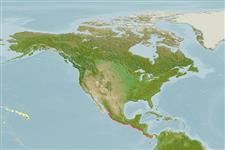Actinopterygii (ray-finned fishes) >
Perciformes (Perch-likes) >
Centropomidae (Snooks)
Etymology: Centropomus: Greek, kentron = sting + Greek, poma, -atos = cover, operculum (Ref. 45335). More on author: Jordan, Gilbert.
Environment / Climate / Range
Ecology
Marine; brackish; pelagic-neritic. Tropical, preferred ?; 25°N - 4°N
Eastern Pacific: Gulf of California to northern Colombia.
Size / Weight / Age
Maturity: Lm ? range ? - ? cm
Max length : 34.5 cm TL male/unsexed; (Ref. 9284); common length : 25.0 cm TL male/unsexed; (Ref. 55763)
Body elongate and somewhat compressed; dorsal profile slightly concave above the eyes; lateral line extending to posterior edge of caudal fin; second anal spine, when folded down, reaching or surpassing origin of caudal fin; pectoral and pelvic fins sub-equal; first gill arch with 26 to 31 gill rakers; back blue gray; belly white; lateral line pale; membranes between dorsal spines and between second and third anal spines pale (Ref. 55763).
Adults are found mainly in estuaries but also enter freshwater to an elevation of 50 m. Diet consists primarily of fish, crustaceans and mollusks (Ref. 36880).
Life cycle and mating behavior
Maturity | Reproduction | Spawning | Eggs | Fecundity | Larvae
Bussing, W.A., 1995. Centropomidae. Róbalos. p. 987-995. In W. Fischer, F. Krupp, W. Schneider, C. Sommer, K.E. Carpenter and V. Niem (eds.) Guia FAO para Identification de Especies para lo Fines de la Pesca. Pacifico Centro-Oriental. 3 Vols. FAO, Rome. (Ref. 9284)
IUCN Red List Status (Ref. 115185)
CITES (Ref. 94142)
Not Evaluated
Threat to humans
Harmless
Human uses
Fisheries: commercial; gamefish: yes
More information
Common namesSynonymsMetabolismPredatorsEcotoxicologyReproductionMaturitySpawningFecundityEggsEgg development
ReferencesAquacultureAquaculture profileStrainsGeneticsAllele frequenciesHeritabilityDiseasesProcessingMass conversion
Tools
Special reports
Download XML
Internet sources
